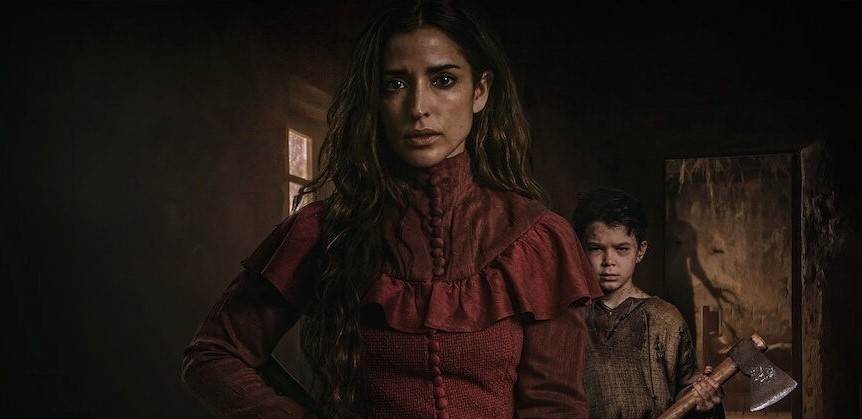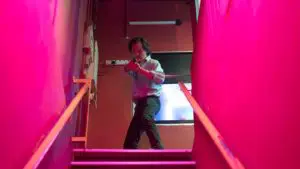Summary
You wouldn’t want to live in The Wasteland, but it’s worth the visit if you like your horror to come with obvious metaphors attached.
This review of The Wasteland is spoiler-free.
Judging by the critical reception, it seems I like David Casademunt’s The Wasteland more than most do, which is as much a surprise to me as anyone. Usually, I’m not in the market for allegorical horror with its capital-T Themes, and even more irritated by its gratingly self-important fanbase, the kind of people who have “A24 stan” in their Twitter bios and unironically use the word “masterpiece” all the time. Luckily, audiences don’t seem to have enjoyed The Wasteland very much either, which leaves me comfortably alone on my little rock of self-satisfaction in the middle of an endlessly churning sea of – ahem – discourse. Which is just the way I like it, obviously.
But I really did like The Wasteland. I didn’t love it for reasons that’ll hopefully become clear, but for the most part, I found it to be an engaging, genuinely suspenseful attempt at “serious” horror. There’s a case to be made that it’s perhaps too serious for its own good, but to be fair there isn’t much to smile about in its depiction of rural 19th-Century Spain, where homesteads dot a half-dead landscape like scabs on the Devil’s balding scalp. And what’s worse is that there might be a “beast” roaming the plains, treating terror as an invitation to loom closer and closer to home, until it eventually drives all nearby to madness and inevitably death.
The legend of this beast, which is a bit like what you’d get if you crossed Slenderman with a Jehovah’s Witness, is recounted to young Diego (Asier Flores) as a cautionary tale by his joyless father Salvador (Roberto Alamo), who is trying to get him ready for the brutal wilderness by gifting him a rifle with his name monogrammed on it, pushing him to club rabbits to death, and telling him stories that’ll ensure he never sleeps again – not that he sleeps much anyway.
Diego’s mother, Lucia (Inma Cuesta), is a much softer touch, even though she has the hilarious horror-movie hobby of carving creepy figurines. She wants to preserve Diego’s innocence as much as possible, which is admittedly hard when he must be escorted to the outhouse by one of his parents and a trusty shotgun. Even the property itself seems designed to terrify him, lined as it is with scarecrows, its dry earth yielding only the kind of crops that are actively hostile to children. Feed your kids enough cabbage and they will certainly go mad. If anything, Diego has proved his mettle by holding out as long as he has.
The problem with Diego, which really begins to manifest when Salvador is forced to leave the homestead after a gruesome incident and leave his wife and child to fend for themselves, is that he’s annoying. Not Asier Flores, who plays him – he’s very good. But the character is written as a belligerent little idiot who never, ever listens to very good advice, always makes the worst decision in any given scenario, and just generally causes Lucia all kinds of problems. He’s supposed to be that way, of course, but sometimes the script – by Casademunt, Martí Lucas, and Fran Menchón – leans too heavily against the crutch.
It’s forgivable, though, since The Wasteland doesn’t rely on too many obvious devices or tricks. There aren’t many jump-scares. In fact, for most of the runtime, there isn’t even a monster, and even when there is you’re never sure if it’s real or imagined. The point is to focus on Diego and Lucia as one or perhaps both lose their marbles. It’s here that I thought the film was admirable. Cuesta’s performance is consistently excellent, and simply the threat of what’s out there, or even the question of whether there’s anything out there at all, seems like enough to pull audiences through. I was invested. Impressed, even. It’s only late in the 90-minute runtime that the whole thing starts to fall apart a bit, and even then, it doesn’t collapse completely.
The issue is just that an early sentiment about fear gives away how the coming-of-age elements are going to factor into the supposed supernaturalism, so the climax is flattened a bit. And that comes after a late turn into more familiar genre territory that loses some ambiguity and a lot of tension as a result. It’s always true in horror that nothing on-screen can ever be as scary as what your imagination can conjure, and while The Wasteland doesn’t overdo things with the visual effects – and some of the practical ones are great – I much preferred the idea of the monster over the monster itself, at least to the extent that there’s even a monster involved at all.
For a movie about quarantining made in the middle of an actual quarantine, though, we can’t be too harsh. With just three actors total and two for the majority of the time, one set, a modest budget, and some ideas that have mostly been cribbed from elsewhere – the mother-son relationship from The Babadook; a lonely plainswoman’s steady descent into madness from The Wind – it’s surprising how much mileage The Wasteland gets out of its premise.



